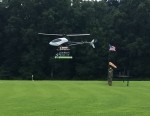
Tuesday, July 1st, 2014
One of the more impressive earth observation achievements in recent years was the collaboration between Google and the University of Maryland to create a global forest change assessment and visualization. This effort was unprecedented in terms of the raw computing power applied to the substantial Landsat archive, and yielding results that opened a lot of

Tuesday, June 10th, 2014
Google Earth is all about putting things in geographic context, aiding literacy and helping users in discovery. This capacity that started out with Keyhole technology has continuously evolved to include more data, and greater usability now with direct interface integration with Google Maps. From its early origins, the tool has also been applied to local

Tuesday, May 27th, 2014
The United Nations Environment Program is responsible for assisting countries in the collection of environmental data for more informed development, improving their quality of life without compromising that of future generations. Jacqueline McGlade, formerly the executive director of the European Environment Agency for ten years, recently joined this group as Chief Scientist, bringing her passion

Tuesday, May 13th, 2014
International efforts to mitigate climate change hinge on limiting global anthropogenic CO2 emissions. About 12 percent of these emissions are due to deforestation and forest degradation, mostly in developing countries. To limit forest emissions, in 2008 the United Nations launched its Collaborative Program on Reducing Emissions from Deforestation and Forest Degradation in Developing Countries (UN-REDD). Building

Monday, February 24th, 2014
Unmanned aerial systems (UAS) have recently become ubiquitous in the mass media and in trade publications, due to a variety of factors that include : international controversy over their military use by the United States against targets in Pakistan; domestic concerns about potential privacy violations; the development of ever cheaper and more capable systems; congressional

Monday, December 16th, 2013
A recent opinion piece by Kirk Goldsberry, visiting scholar at Harvard University, gained a good deal of attention because it advocated for a return of a geography department to that august institution. Sensors & Systems (S&S) special correspondent Matteo Luccio spoke with Goldsberry about his background, about the need to reveal spatial patterns, and

Tuesday, November 26th, 2013
Currently, about a dozen government and commercial Earth-imaging satellites circle the Earth daily. They take thousands of pictures that governments, private companies, and non-governmental organizations (NGOs) use for purposes as varied as monitoring wheat production, looking for point sources of pollution, and displaying images on Google Earth.

Monday, October 14th, 2013
SkyTruth has a mission to use remote sensing and digital mapping to educate the public and policymakers about the environmental consequences of human activity. Sensors & Systems (S&S) special correspondent Matteo Luccio recently spoke with John Amos, president of SkyTruth, about the organization’s motive and mission. Included in the conversation are details on imagery sources,

Monday, August 5th, 2013
The advent of Earth-observation satellites transformed how we view our planet—from occasional snapshots to near continuous, comprehensive, and real-time coverage. Likewise, the advent of cabled sensor networks on the sea floor is beginning to provide scientists and the public with a continuous flow of data, including video streams, that will revolutionize our understanding of

Monday, August 5th, 2013
There’s an ongoing need to apply spatial and temporal intelligence to make sense of change. The Pacific Marine Analysis and Research Association (PacMARA) is an organization that is applying decision support tools for ecosystem-based decision making for marine spatial planning. Sensors & Systems (S&S) special correspondent Matteo Luccio spoke with Henry Kucera, director of the